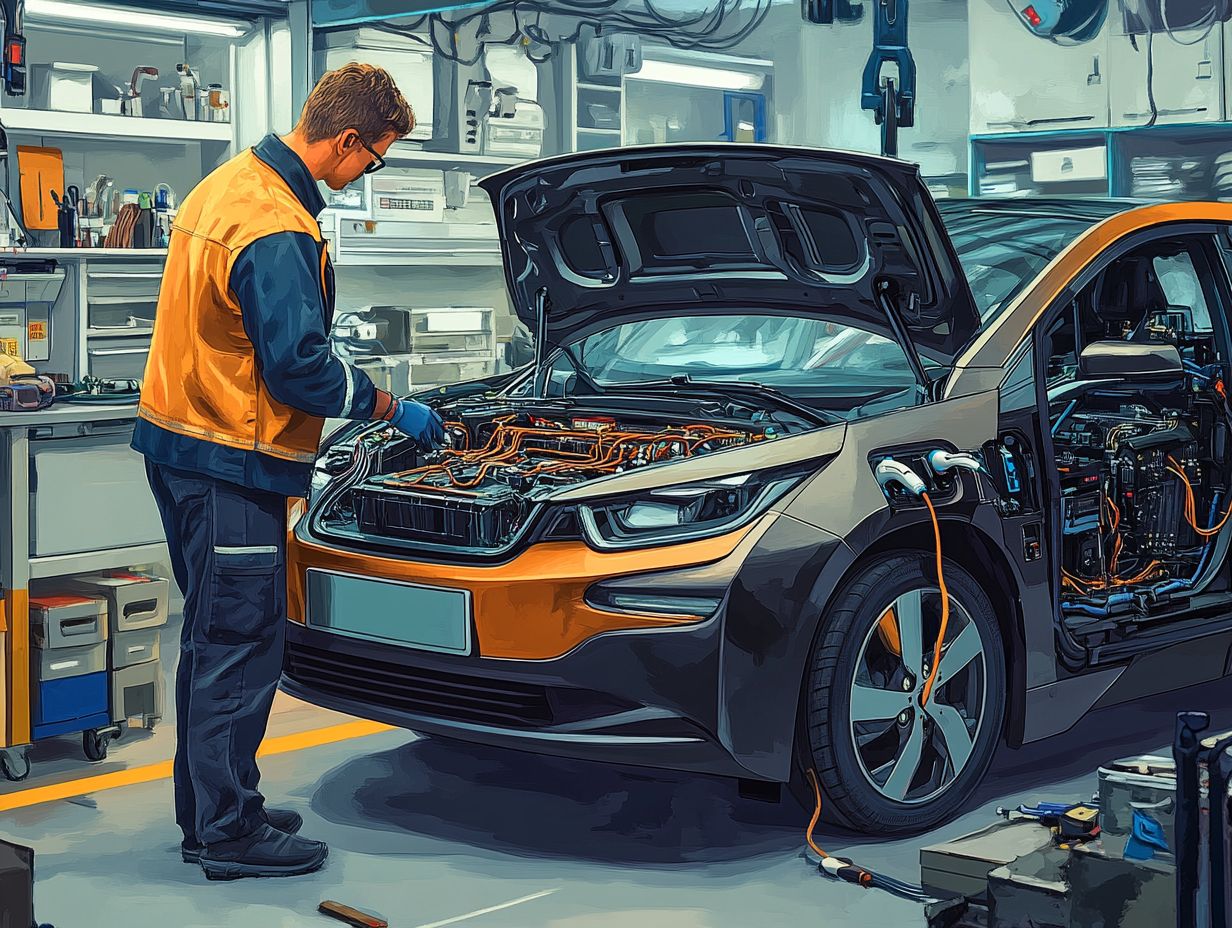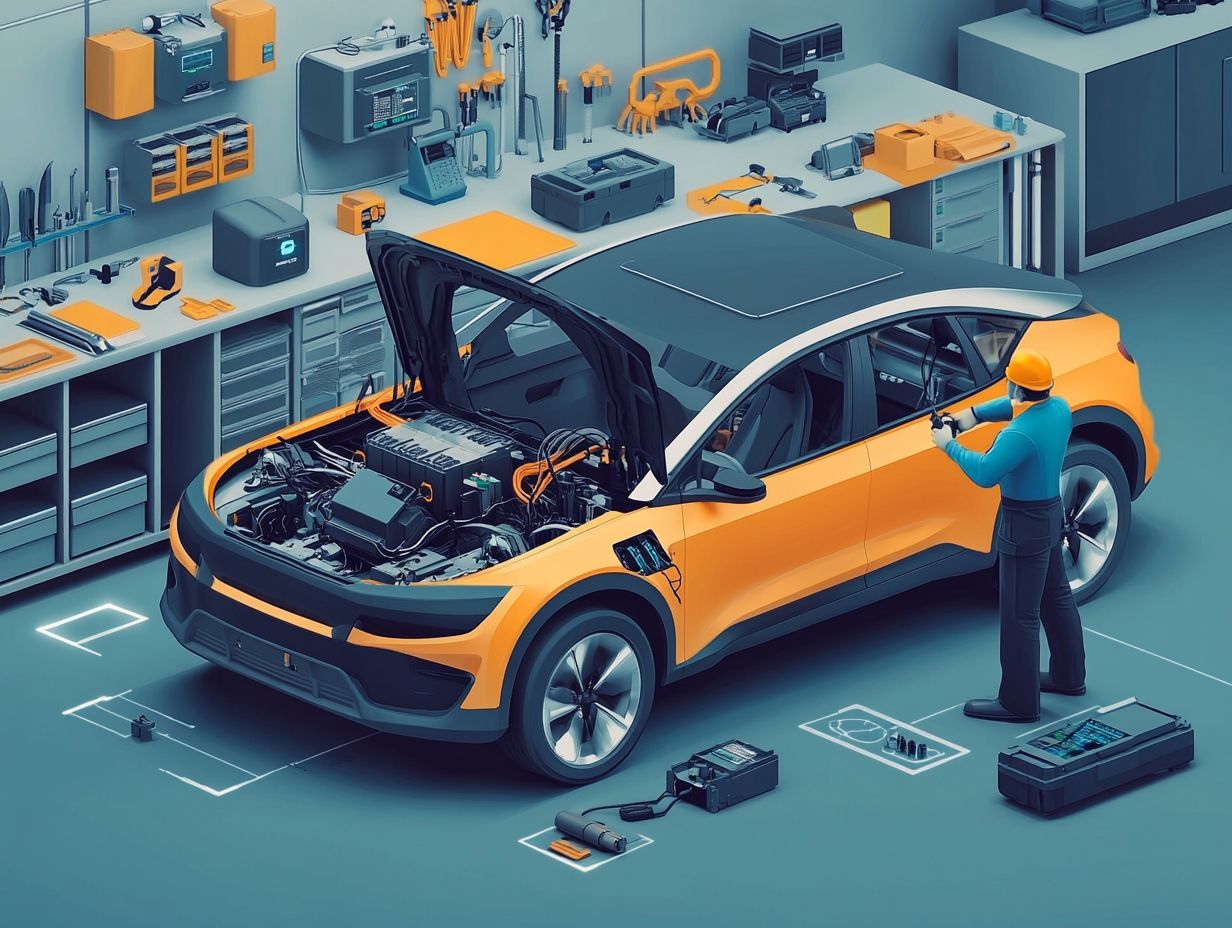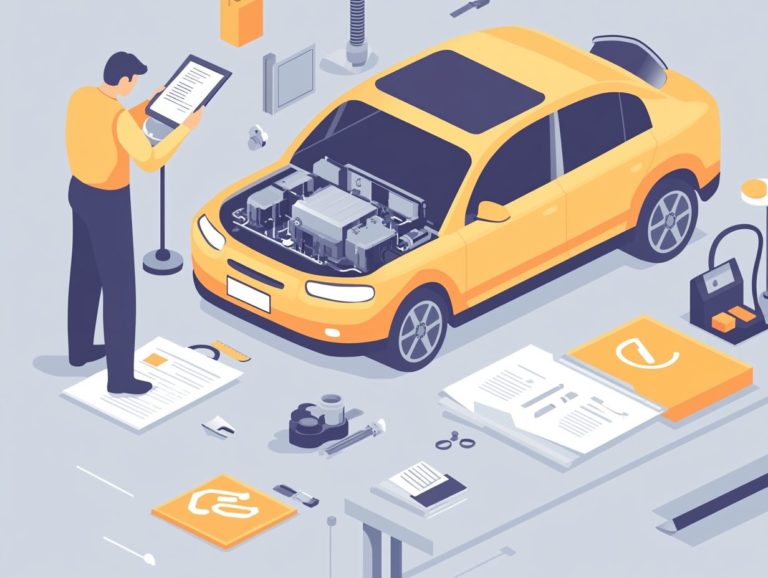Learning to Diagnose Common EV Problems
Electric vehicles (EVs) are revolutionizing the landscape of transportation, yet they are not immune to issues that can arise from time to time.
You’ll explore common problems and their symptoms, equipping you with the insights to identify warning signs before they escalate into more significant concerns.
Essential diagnostic tools, such as OBD-II scanners, which are tools that help you read error codes, will be highlighted to aid you in pinpointing and troubleshooting issues effectively.
You will also find a step-by-step guide for repairs, along with preventive maintenance tips, ensuring that your EV continues to operate at its best.
Dive in and empower yourself with the knowledge needed to care for your electric vehicle with confidence!
Contents
- Key Takeaways:
- Common EV Problems and Symptoms
- Diagnostic Tools and Techniques
- Troubleshooting and Repairing EV Issues
- Preventive Maintenance for EVs
- Frequently Asked Questions
- What are some common problems that can occur with electric vehicles?
- Why is it important to learn how to diagnose common EV problems?
- What are some steps to follow when diagnosing a potential issue with an electric vehicle?
- Can EV problems be prevented?
- Do all electric vehicles have the same types of problems?
- Is it safe to diagnose and fix EV problems on my own?
Key Takeaways:

- Regular maintenance and monitoring for warning signs can prevent major EV issues.
- OBD-II scanners and other diagnostic tools are essential for identifying and resolving EV problems.
- A step-by-step approach to troubleshooting and repairing EV issues can save time and money.
Understanding Electric Vehicles
Understanding electric vehicles (EVs) means more than just recognizing them as cars that run on electricity. These vehicles use advanced technology, such as electric motors, which offer a cleaner alternative to traditional combustion engines.
Their complex battery packs fuel a variety of functionalities, making them not just vehicles but sophisticated machines. You can’t underestimate the importance of efficient EV diagnostics; they ensure your vehicle performs at its best while maximizing energy efficiency.
From managing the charging system to braking that recovers energy, having a solid grasp of these elements is crucial for both consumers and automotive technicians.
The evolution of electric vehicles has been remarkable, moving from niche products to mainstream choices that significantly cut carbon emissions and reduce dependence on fossil fuels. This transformation is fueled by a blend of technological advancements, government incentives, and increasing consumer awareness of environmental issues.
With components like high-capacity lithium-ion batteries, you can enjoy longer ranges and quicker charging times. Advanced onboard computers help manage your vehicle’s energy consumption. As the industry embraces innovation, understanding these systems isn’t just for enthusiasts it’s essential for everyday drivers who want to contribute to a more sustainable future.
Common EV Problems and Symptoms
As an electric vehicle owner, it’s important to be aware of the common issues you may encounter. You might experience charging problems that can lead to a reduced range, a noticeable loss of power during acceleration, or even peculiar noises coming from the electric motor.
Staying informed about these symptoms can help you address any concerns promptly and ensure a smoother driving experience.
Identifying Issues and Warning Signs
Spotting issues in your EV can save you time and money. Identifying warning signs is essential for maintaining its performance and reliability.
Diagnostic tools play a pivotal role in this process, enabling you to read error codes that may point to potential faults in electrical connections or loose wiring issues that can escalate into more significant problems if left unchecked.
Along with utilizing these tools, it s vital to pay close attention to the warning lights on your dashboard, as they can offer immediate alerts about various system malfunctions. For instance, if the battery warning light lights up, it may indicate concerns with the charging system, warranting further investigation.
You should also stay alert for any unusual symptoms, such as sudden drops in power or significant changes in range, as these could signal thermal management failures or other underlying issues.
Regular maintenance checks are crucial to avoid costly repairs down the road! They help you catch problems early and ensure the longevity and efficiency of your vehicle.
Diagnostic Tools and Techniques

Using the right diagnostic tools is crucial for your success! When diagnosing electric vehicle issues, it’s essential to use appropriate diagnostic tools and techniques. Among these, OBD-II scanners stand out as some of the most frequently employed diagnostic systems.
These tools enable you to swiftly assess a vehicle’s performance and uncover any underlying problems.
Using OBD-II Scanners and Other Tools
Utilizing OBD-II scanners and other diagnostic tools is vital for effective EV diagnostics. These devices offer critical insights into the battery management system and can interpret error codes that signify various faults.
With these tools at your disposal, you can access the vehicle s onboard computer, unveiling real-time data and historical information that are crucial for diagnosing issues. By grasping the specific error codes generated by the system, you can swiftly pinpoint malfunctions related to battery performance, charging cycles, and overall vehicle efficiency.
This understanding helps you rectify immediate faults and enhances your preventative maintenance strategies. It ensures that electric vehicles operate at their best over time. Recognizing how different codes relate to the powertrain and electrical systems emphasizes the importance of proactive diagnostics in maintaining the longevity and reliability of EV technology.
Troubleshooting and Repairing EV Issues
Regarding troubleshooting and repairing EV issues, adopting a systematic approach is essential. Begin with diagnostic tools to identify the root of any mechanical faults and evaluate necessary battery maintenance.
This proactive strategy streamlines the repair process and significantly impacts maintenance costs and the necessity for professional servicing down the line.
Step-by-Step Guide to Diagnosing and Fixing Problems
Ready to tackle EV problems? Follow this step-by-step guide! A step-by-step guide to diagnosing and fixing problems in electric vehicles involves applying various diagnostic techniques to evaluate battery performance and identify common electric vehicle repairs and electrical issues.
This process requires a comprehensive understanding of the vehicle’s systems and a systematic approach that begins with a thorough inspection of both the battery and the charging components.
By using specialized diagnostic tools like multimeters and scan tools, you can pinpoint areas that may be malfunctioning. It s crucial to analyze error codes and interactive interfaces to grasp the underlying issues.
Staying abreast of emerging EV technologies is essential, ensuring that you can tackle contemporary challenges efficiently. By honing these skills and employing effective troubleshooting methods, you can significantly enhance vehicle performance and longevity.
Preventive Maintenance for EVs

Preventive maintenance for electric vehicles is essential for ensuring both longevity and optimal performance. By implementing key maintenance strategies such as closely monitoring your charging habits, conducting regular battery upkeep, and maintaining proper tire pressure you can significantly enhance charging efficiency and overall vehicle health.
Prioritizing these practices will not only extend the life of your vehicle but also ensure that it operates at its best, providing a smoother and more enjoyable driving experience.
Preventive maintenance ensures your EV runs smoothly.
Tips for Keeping Your EV in Top Condition
To keep your electric vehicle in peak condition, concentrate on maintaining battery health and using charging stations wisely. It’s also crucial to monitor the thermal management system to prevent overheating and ensure the overall well-being of your electric car.
Regularly inspecting the battery’s state of charge is vital; allowing it to drop to low levels consistently can diminish its lifespan over time. Consider charging your EV during off-peak hours when rates may be more favorable, ensuring it remains charged without incurring unnecessary costs.
Additionally, pay close attention to the thermal management system, as it is instrumental in sustaining optimal battery performance. You can enhance this by checking for software updates that might improve efficiency and performance, along with monitoring the cooling and heating processes that shield the battery from extreme temperatures.
Frequently Asked Questions
What are some common problems that can occur with electric vehicles?
Some common problems that can occur with electric vehicles include battery degradation, charging issues, and electronic malfunctions.
Why is it important to learn how to diagnose common EV problems?

Learning how to diagnose common EV problems can save you time and money by avoiding unnecessary trips to the mechanic and understanding EV electronics and maintenance to fix minor issues yourself.
What are some steps to follow when diagnosing a potential issue with an electric vehicle?
Some steps to follow when diagnosing a potential issue with an electric vehicle include checking the battery charge, inspecting the charging port, and monitoring any error messages on the dashboard.
Can EV problems be prevented?
Yes, some common EV problems can be prevented by regularly maintaining the vehicle, following proper charging procedures, and being aware of warning signs of potential issues.
Do all electric vehicles have the same types of problems?
No, different electric vehicles can have different types of problems depending on their specific make and model. It’s important to familiarize yourself with the specific EV you own to better understand potential issues.
Is it safe to diagnose and fix EV problems on my own?
It is generally safe to diagnose and fix minor EV problems on your own, but if you are unsure or uncomfortable, it’s best to consult a professional mechanic or the manufacturer for assistance.




